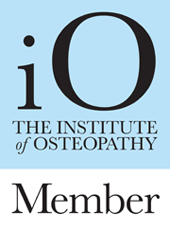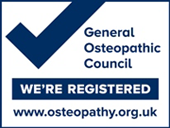Osteopathy
Osteopathy is a primary health care system complementary to other medical practices. It focuses on the adjustment of poor musculoskeletal function, allowing the body to heal naturally and efficiently. Osteopathy can provide relief for simple mechanical problems and contribute to the management of a range of long-term complaints. It is suitable for almost anyone from babies to the elderly, using a patient-centred and holistic approach to restore normal tissue health and function.
Our Training
Our extensive osteopathic training (4-5 years) includes anatomy, physiology, pathology, neurology, biomechanics and clinical skills. It enables us to examine all systems of the body, diagnosing mechanical problems along the way.
We are fully committed to updating our clinical knowledge through compulsory continual professional development (CPD) each year.
The General Osteopathic Council
All osteopaths practicing in the United Kingdom are registered with the General Osteopathic Council (GOsC). The GOsC was established under the Osteopaths Act (1993) to regulate and promote osteopathy, ensuring that the highest standards of safety, proficiency and CPD are retained.
Osteopathy and GPs
Most patients self refer to an osteopath for treatment. Although referral by a GP is not necessary, we encourage our patients to keep their GP informed. This facilitates the upkeep of all patient medical records and ensures the best possible care from all healthcare practitioners involved.
GPs may refer patients to osteopaths where they believe our intervention would be beneficial. Access to osteopathy on the NHS in Bedfordshire and Buckinghamshire is limited, but services are becoming more widespread as commissioning authorities recognise the benefits of providing osteopathy to patients. Some GP surgeries have more control over their budget than others and it is recommended that patients ask their GP if they are offering osteopathy as a service.
If we feel that a patient needs to see a GP or another medical professional, we will collaborate as appropriate to achieve the best possible outcome.
Our Techniques
Osteopathy is a hands-on therapy, which uses a range of techniques to increase the mobility and function of tissues throughout the body. The aim is to enhance the blood and nerve supply to the tissues, in order to promote the body’s own healing mechanisms. Some of our techniques include:
Joint manipulation and articulation – easing joint restriction, relieving pain, promoting nerve function between the site of the symptoms and segments of the spine, allowing better movement away from the site of the pain.
Cranio-sacral techniques – applying subtle movement to the bones of the head and spine commonly used with patients requiring a more gentle treatment approach such as babies and children or those with chronic headaches.
Visceral techniques – applying gentle techniques on the viscera (internal organs) to assist digestive and circulatory problems or breathing difficulties.
Soft-tissue massage and stretching – improving range of motion and muscle flexibility.
Dry-needling – reducing myofascial (muscle) pain with acupuncture needles.
Taping and strapping – providing pain relief and support for patients needing to carry on with work or training.
Appointments
Patients should allow up to 1-hour for initial appointments and 30-minutes for follow-up sessions. The first visit will include time for discussion about a patient’s problem, their general health and any other medical care that they are receiving. All information shared with us is confidential.
Examination and assessment of joints, tissues and ligaments will be performed. Patients may be asked to remove some clothing to allow assessment of posture and movements and are therefore requested to come appropriately dressed. Chaperones (a friend or relative) are welcome.
A diagnosis and an individual treatment plan will be explained based on the findings of our examinations.
Further visits may be required in order to monitor progress and ensure that our treatment plan remains appropriate and effective.
If a patient’s symptoms require further medical investigation such as scans or blood tests, we will refer them to their GP or another appropriate medical professional.
Modern Acupuncture
Modern acupuncture (also known as dry needling or Western medicine acupuncture) is an adaptation of traditional Chinese medicine acupuncture. Rather than focusing on concepts such as Ying/Yang and the circulation of Ch’i, we apply our current knowledge of anatomy, physiology, pathology and the principles of evidence-based medicine with modern acupuncture during a treatment session.
By way of an introduction, myofascial pain literally means pain coming from the muscles (myo is Latin for muscle and fascia is connective tissue beneath the skin, enclosing and separating muscles and other internal organs). Symptoms of myofascial pain may vary depending on its location, severity and chronicity. It can be constant or intermittent. Movement of the affected muscle or muscle group will aggravate myofascial pain, often stimulating other complaints such as a burning or stabbing sensation, muscle weakness and numbness or tingling. Aggravating factors for myofascial pain include prolonged sitting, cold weather, repetitive activities (such as driving, computer use and decorating) and stress.
Trigger points are hyperirritable spots in the fascia surrounding muscles. They cause muscles to become abnormally sensitive, resulting in tight bands of muscle or fascia that can stimulate either local pain or refer pain to another region of the body.
As osteopaths we regularly employ modern acupuncture as an adjunct to our other manual therapy techniques in the treatment of trigger points and myofascial pain. We aim to relax the affected muscle or muscle group as a result of the “micro trauma” effect of the acupuncture needle in the surface of the muscle(s) being treated.
Modern acupuncture is often pain-free. The needles we use are extremely fine (with a diameter as small as 0.2mm), they are sterile and we never re-use them so that they remain extremely sharp and easy to insert into the skin.
The relief from myofascial pain via modern acupuncture can be immediate. In other instances a course of treatments is required to deactivate the trigger points in a dysfunctional muscle or muscle group, reeducating the negative pain signals.


